Implementation of Lean Project Management: A Detailed Report
VerifiedAdded on 2022/12/30
|12
|3053
|65
Report
AI Summary
This report examines the implementation of Lean Project Management (LPM) within an organization, emphasizing the shift from traditional project management principles. The memorandum outlines the rationale for adopting LPM to maximize business value and minimize waste, addressing inefficiencies and delays in previous projects. Key points include the initial reasons for implementing LPM, focusing on waste reduction and increased value, and the benefits for various stakeholders such as increased productivity, improved efficiency, and higher product quality. Critical success factors, including managerial commitment, workforce training, and resource allocation, are discussed, alongside the steps to ensure their implementation. The report also covers the achievement of the LPM mindset within the consultancy staff, the description of training requirements, and the assessment methods for adopting the LPM approach for government work, concluding with the overall benefits of LPM in enhancing project outcomes and stakeholder satisfaction.
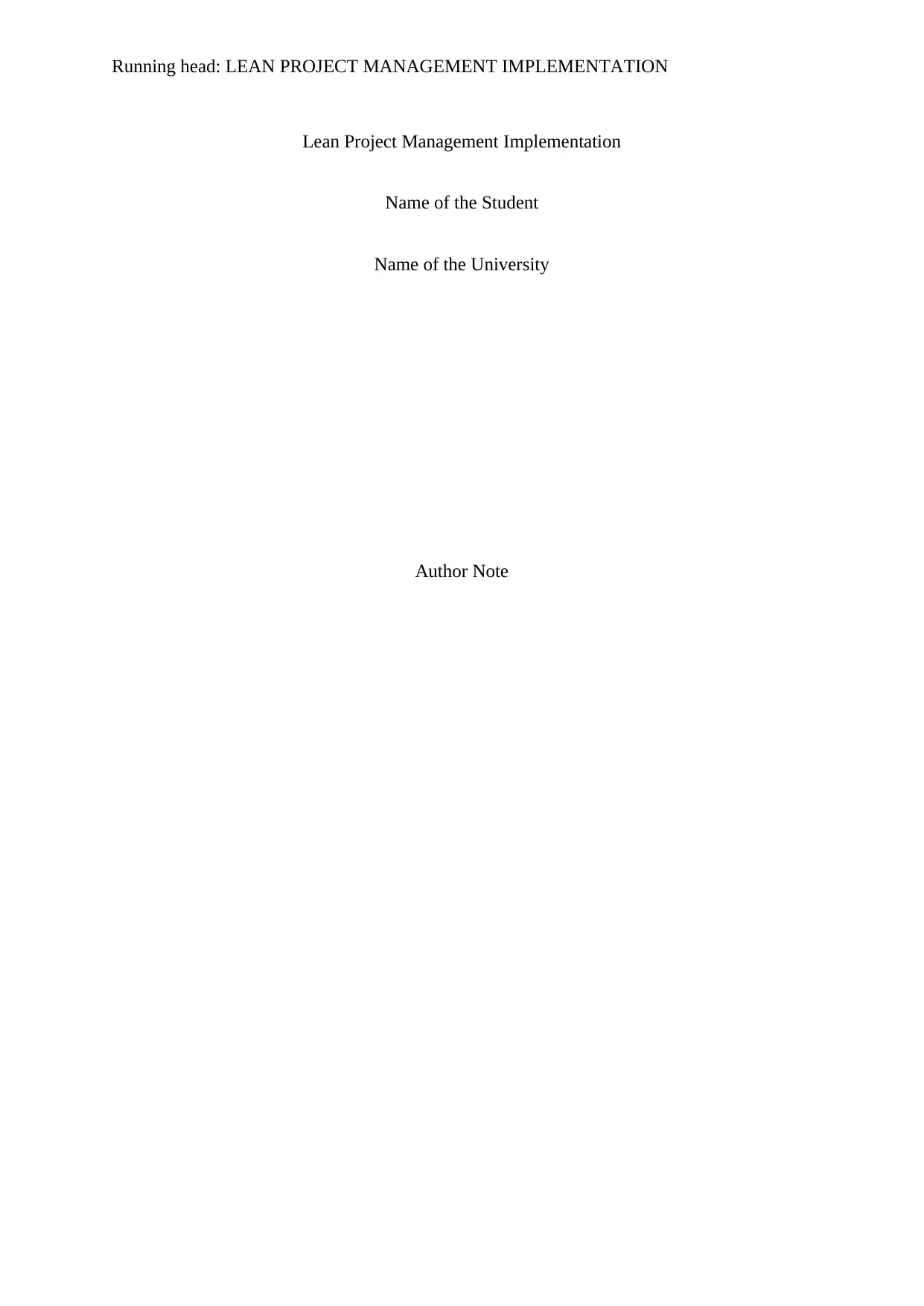
Running head: LEAN PROJECT MANAGEMENT IMPLEMENTATION
Lean Project Management Implementation
Name of the Student
Name of the University
Author Note
Lean Project Management Implementation
Name of the Student
Name of the University
Author Note
Paraphrase This Document
Need a fresh take? Get an instant paraphrase of this document with our AI Paraphraser
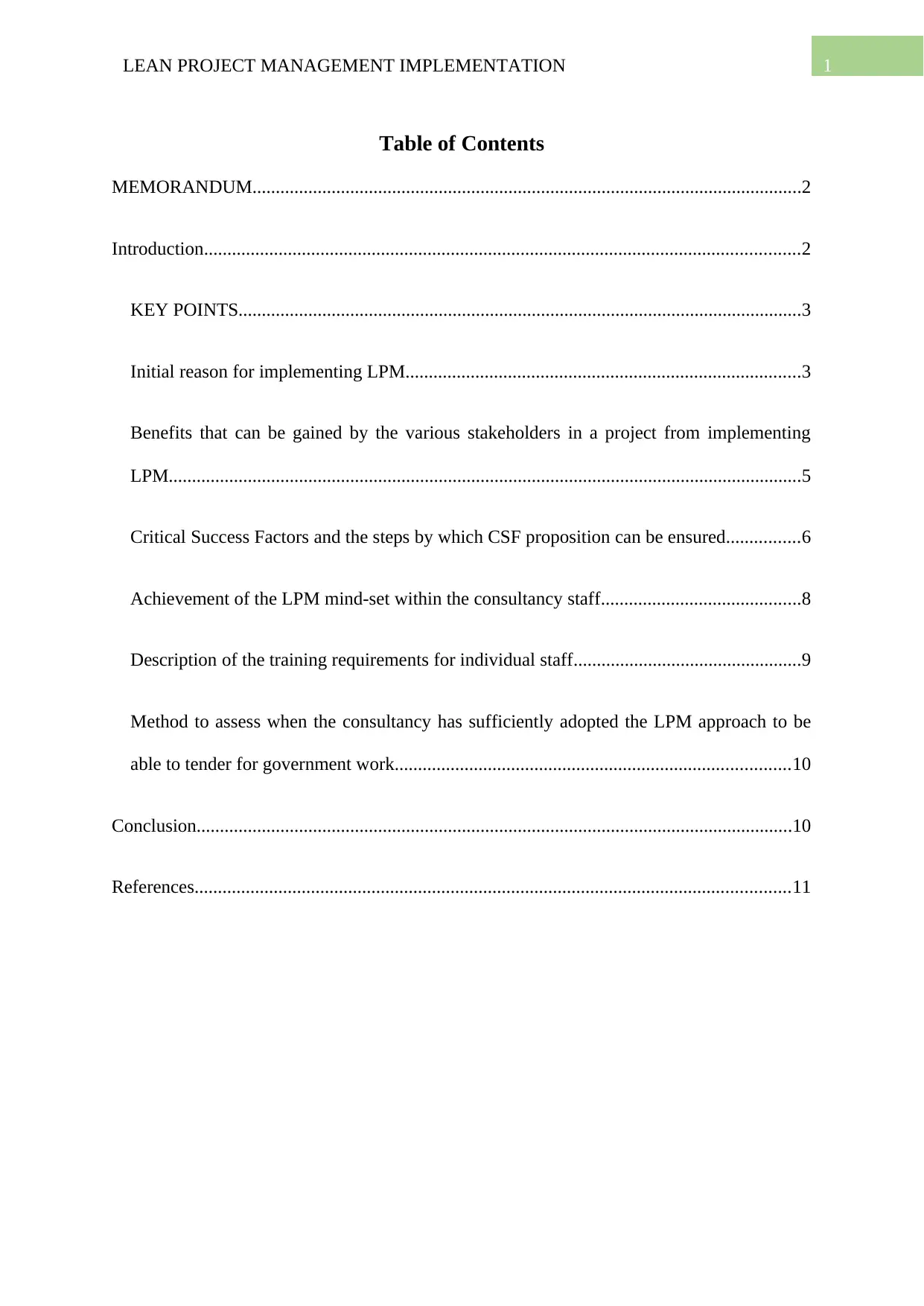
1LEAN PROJECT MANAGEMENT IMPLEMENTATION
Table of Contents
MEMORANDUM......................................................................................................................2
Introduction................................................................................................................................2
KEY POINTS.........................................................................................................................3
Initial reason for implementing LPM.....................................................................................3
Benefits that can be gained by the various stakeholders in a project from implementing
LPM........................................................................................................................................5
Critical Success Factors and the steps by which CSF proposition can be ensured................6
Achievement of the LPM mind-set within the consultancy staff...........................................8
Description of the training requirements for individual staff.................................................9
Method to assess when the consultancy has sufficiently adopted the LPM approach to be
able to tender for government work.....................................................................................10
Conclusion................................................................................................................................10
References................................................................................................................................11
Table of Contents
MEMORANDUM......................................................................................................................2
Introduction................................................................................................................................2
KEY POINTS.........................................................................................................................3
Initial reason for implementing LPM.....................................................................................3
Benefits that can be gained by the various stakeholders in a project from implementing
LPM........................................................................................................................................5
Critical Success Factors and the steps by which CSF proposition can be ensured................6
Achievement of the LPM mind-set within the consultancy staff...........................................8
Description of the training requirements for individual staff.................................................9
Method to assess when the consultancy has sufficiently adopted the LPM approach to be
able to tender for government work.....................................................................................10
Conclusion................................................................................................................................10
References................................................................................................................................11
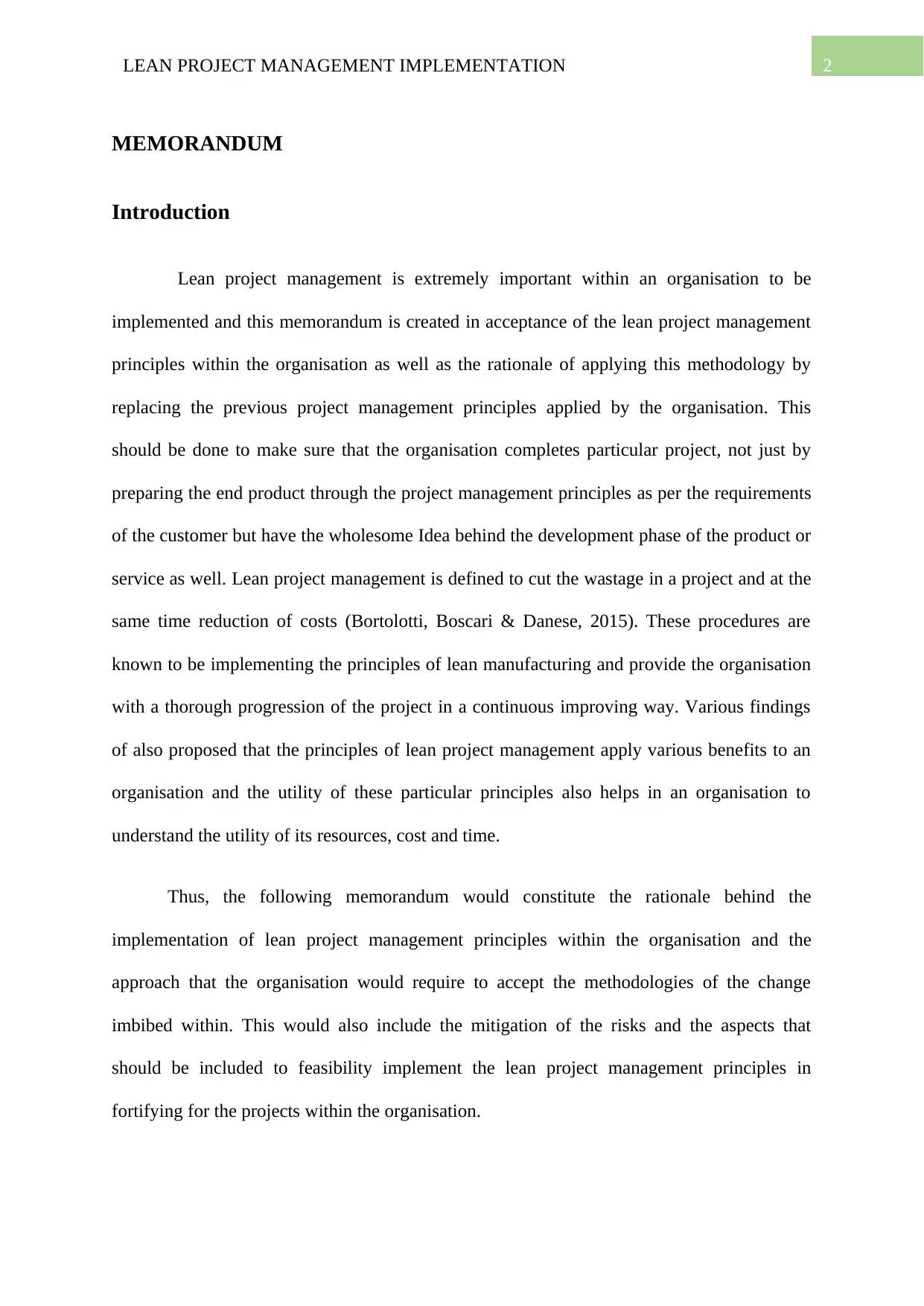
2LEAN PROJECT MANAGEMENT IMPLEMENTATION
MEMORANDUM
Introduction
Lean project management is extremely important within an organisation to be
implemented and this memorandum is created in acceptance of the lean project management
principles within the organisation as well as the rationale of applying this methodology by
replacing the previous project management principles applied by the organisation. This
should be done to make sure that the organisation completes particular project, not just by
preparing the end product through the project management principles as per the requirements
of the customer but have the wholesome Idea behind the development phase of the product or
service as well. Lean project management is defined to cut the wastage in a project and at the
same time reduction of costs (Bortolotti, Boscari & Danese, 2015). These procedures are
known to be implementing the principles of lean manufacturing and provide the organisation
with a thorough progression of the project in a continuous improving way. Various findings
of also proposed that the principles of lean project management apply various benefits to an
organisation and the utility of these particular principles also helps in an organisation to
understand the utility of its resources, cost and time.
Thus, the following memorandum would constitute the rationale behind the
implementation of lean project management principles within the organisation and the
approach that the organisation would require to accept the methodologies of the change
imbibed within. This would also include the mitigation of the risks and the aspects that
should be included to feasibility implement the lean project management principles in
fortifying for the projects within the organisation.
MEMORANDUM
Introduction
Lean project management is extremely important within an organisation to be
implemented and this memorandum is created in acceptance of the lean project management
principles within the organisation as well as the rationale of applying this methodology by
replacing the previous project management principles applied by the organisation. This
should be done to make sure that the organisation completes particular project, not just by
preparing the end product through the project management principles as per the requirements
of the customer but have the wholesome Idea behind the development phase of the product or
service as well. Lean project management is defined to cut the wastage in a project and at the
same time reduction of costs (Bortolotti, Boscari & Danese, 2015). These procedures are
known to be implementing the principles of lean manufacturing and provide the organisation
with a thorough progression of the project in a continuous improving way. Various findings
of also proposed that the principles of lean project management apply various benefits to an
organisation and the utility of these particular principles also helps in an organisation to
understand the utility of its resources, cost and time.
Thus, the following memorandum would constitute the rationale behind the
implementation of lean project management principles within the organisation and the
approach that the organisation would require to accept the methodologies of the change
imbibed within. This would also include the mitigation of the risks and the aspects that
should be included to feasibility implement the lean project management principles in
fortifying for the projects within the organisation.
⊘ This is a preview!⊘
Do you want full access?
Subscribe today to unlock all pages.

Trusted by 1+ million students worldwide
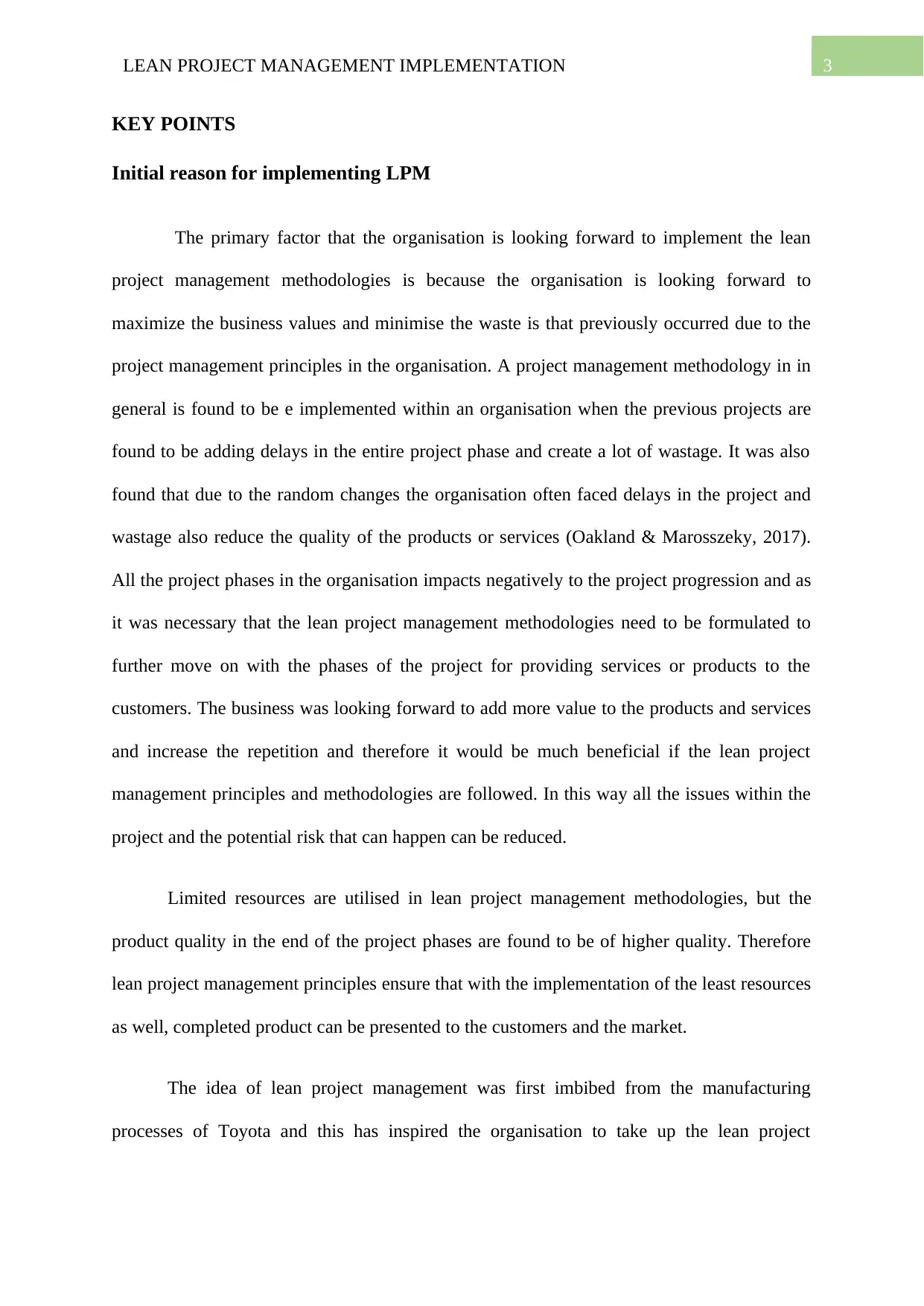
3LEAN PROJECT MANAGEMENT IMPLEMENTATION
KEY POINTS
Initial reason for implementing LPM
The primary factor that the organisation is looking forward to implement the lean
project management methodologies is because the organisation is looking forward to
maximize the business values and minimise the waste is that previously occurred due to the
project management principles in the organisation. A project management methodology in in
general is found to be e implemented within an organisation when the previous projects are
found to be adding delays in the entire project phase and create a lot of wastage. It was also
found that due to the random changes the organisation often faced delays in the project and
wastage also reduce the quality of the products or services (Oakland & Marosszeky, 2017).
All the project phases in the organisation impacts negatively to the project progression and as
it was necessary that the lean project management methodologies need to be formulated to
further move on with the phases of the project for providing services or products to the
customers. The business was looking forward to add more value to the products and services
and increase the repetition and therefore it would be much beneficial if the lean project
management principles and methodologies are followed. In this way all the issues within the
project and the potential risk that can happen can be reduced.
Limited resources are utilised in lean project management methodologies, but the
product quality in the end of the project phases are found to be of higher quality. Therefore
lean project management principles ensure that with the implementation of the least resources
as well, completed product can be presented to the customers and the market.
The idea of lean project management was first imbibed from the manufacturing
processes of Toyota and this has inspired the organisation to take up the lean project
KEY POINTS
Initial reason for implementing LPM
The primary factor that the organisation is looking forward to implement the lean
project management methodologies is because the organisation is looking forward to
maximize the business values and minimise the waste is that previously occurred due to the
project management principles in the organisation. A project management methodology in in
general is found to be e implemented within an organisation when the previous projects are
found to be adding delays in the entire project phase and create a lot of wastage. It was also
found that due to the random changes the organisation often faced delays in the project and
wastage also reduce the quality of the products or services (Oakland & Marosszeky, 2017).
All the project phases in the organisation impacts negatively to the project progression and as
it was necessary that the lean project management methodologies need to be formulated to
further move on with the phases of the project for providing services or products to the
customers. The business was looking forward to add more value to the products and services
and increase the repetition and therefore it would be much beneficial if the lean project
management principles and methodologies are followed. In this way all the issues within the
project and the potential risk that can happen can be reduced.
Limited resources are utilised in lean project management methodologies, but the
product quality in the end of the project phases are found to be of higher quality. Therefore
lean project management principles ensure that with the implementation of the least resources
as well, completed product can be presented to the customers and the market.
The idea of lean project management was first imbibed from the manufacturing
processes of Toyota and this has inspired the organisation to take up the lean project
Paraphrase This Document
Need a fresh take? Get an instant paraphrase of this document with our AI Paraphraser
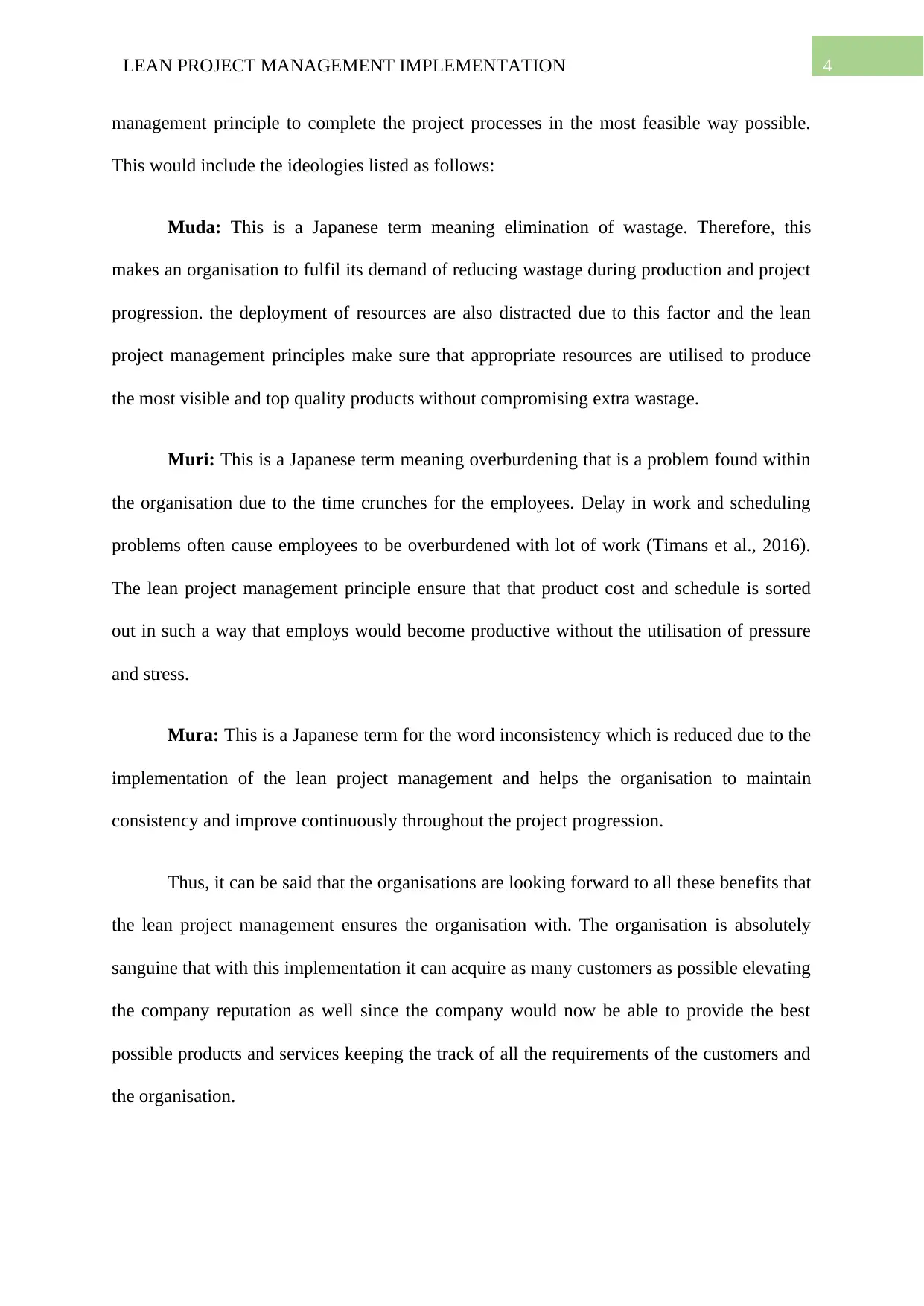
4LEAN PROJECT MANAGEMENT IMPLEMENTATION
management principle to complete the project processes in the most feasible way possible.
This would include the ideologies listed as follows:
Muda: This is a Japanese term meaning elimination of wastage. Therefore, this
makes an organisation to fulfil its demand of reducing wastage during production and project
progression. the deployment of resources are also distracted due to this factor and the lean
project management principles make sure that appropriate resources are utilised to produce
the most visible and top quality products without compromising extra wastage.
Muri: This is a Japanese term meaning overburdening that is a problem found within
the organisation due to the time crunches for the employees. Delay in work and scheduling
problems often cause employees to be overburdened with lot of work (Timans et al., 2016).
The lean project management principle ensure that that product cost and schedule is sorted
out in such a way that employs would become productive without the utilisation of pressure
and stress.
Mura: This is a Japanese term for the word inconsistency which is reduced due to the
implementation of the lean project management and helps the organisation to maintain
consistency and improve continuously throughout the project progression.
Thus, it can be said that the organisations are looking forward to all these benefits that
the lean project management ensures the organisation with. The organisation is absolutely
sanguine that with this implementation it can acquire as many customers as possible elevating
the company reputation as well since the company would now be able to provide the best
possible products and services keeping the track of all the requirements of the customers and
the organisation.
management principle to complete the project processes in the most feasible way possible.
This would include the ideologies listed as follows:
Muda: This is a Japanese term meaning elimination of wastage. Therefore, this
makes an organisation to fulfil its demand of reducing wastage during production and project
progression. the deployment of resources are also distracted due to this factor and the lean
project management principles make sure that appropriate resources are utilised to produce
the most visible and top quality products without compromising extra wastage.
Muri: This is a Japanese term meaning overburdening that is a problem found within
the organisation due to the time crunches for the employees. Delay in work and scheduling
problems often cause employees to be overburdened with lot of work (Timans et al., 2016).
The lean project management principle ensure that that product cost and schedule is sorted
out in such a way that employs would become productive without the utilisation of pressure
and stress.
Mura: This is a Japanese term for the word inconsistency which is reduced due to the
implementation of the lean project management and helps the organisation to maintain
consistency and improve continuously throughout the project progression.
Thus, it can be said that the organisations are looking forward to all these benefits that
the lean project management ensures the organisation with. The organisation is absolutely
sanguine that with this implementation it can acquire as many customers as possible elevating
the company reputation as well since the company would now be able to provide the best
possible products and services keeping the track of all the requirements of the customers and
the organisation.
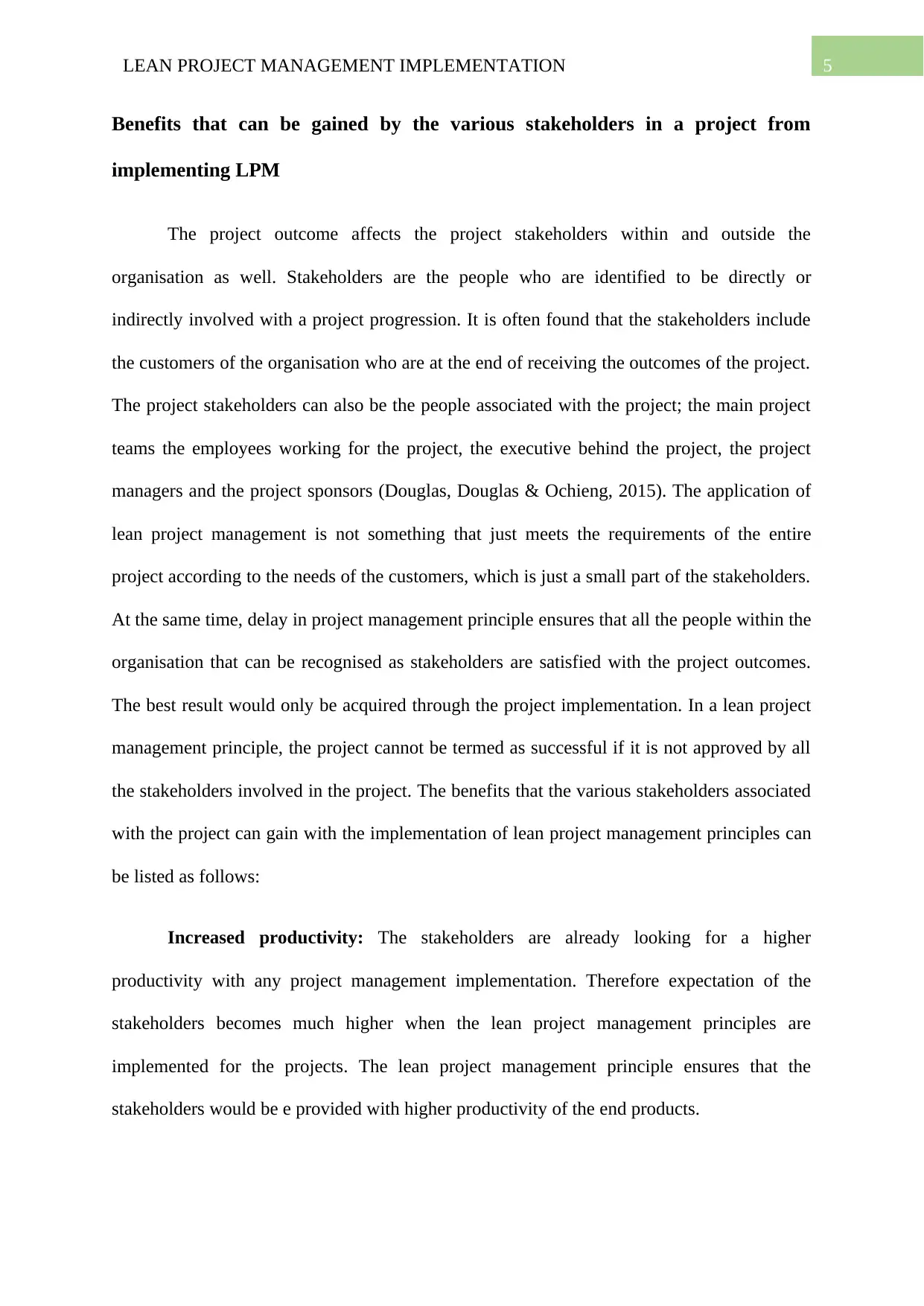
5LEAN PROJECT MANAGEMENT IMPLEMENTATION
Benefits that can be gained by the various stakeholders in a project from
implementing LPM
The project outcome affects the project stakeholders within and outside the
organisation as well. Stakeholders are the people who are identified to be directly or
indirectly involved with a project progression. It is often found that the stakeholders include
the customers of the organisation who are at the end of receiving the outcomes of the project.
The project stakeholders can also be the people associated with the project; the main project
teams the employees working for the project, the executive behind the project, the project
managers and the project sponsors (Douglas, Douglas & Ochieng, 2015). The application of
lean project management is not something that just meets the requirements of the entire
project according to the needs of the customers, which is just a small part of the stakeholders.
At the same time, delay in project management principle ensures that all the people within the
organisation that can be recognised as stakeholders are satisfied with the project outcomes.
The best result would only be acquired through the project implementation. In a lean project
management principle, the project cannot be termed as successful if it is not approved by all
the stakeholders involved in the project. The benefits that the various stakeholders associated
with the project can gain with the implementation of lean project management principles can
be listed as follows:
Increased productivity: The stakeholders are already looking for a higher
productivity with any project management implementation. Therefore expectation of the
stakeholders becomes much higher when the lean project management principles are
implemented for the projects. The lean project management principle ensures that the
stakeholders would be e provided with higher productivity of the end products.
Benefits that can be gained by the various stakeholders in a project from
implementing LPM
The project outcome affects the project stakeholders within and outside the
organisation as well. Stakeholders are the people who are identified to be directly or
indirectly involved with a project progression. It is often found that the stakeholders include
the customers of the organisation who are at the end of receiving the outcomes of the project.
The project stakeholders can also be the people associated with the project; the main project
teams the employees working for the project, the executive behind the project, the project
managers and the project sponsors (Douglas, Douglas & Ochieng, 2015). The application of
lean project management is not something that just meets the requirements of the entire
project according to the needs of the customers, which is just a small part of the stakeholders.
At the same time, delay in project management principle ensures that all the people within the
organisation that can be recognised as stakeholders are satisfied with the project outcomes.
The best result would only be acquired through the project implementation. In a lean project
management principle, the project cannot be termed as successful if it is not approved by all
the stakeholders involved in the project. The benefits that the various stakeholders associated
with the project can gain with the implementation of lean project management principles can
be listed as follows:
Increased productivity: The stakeholders are already looking for a higher
productivity with any project management implementation. Therefore expectation of the
stakeholders becomes much higher when the lean project management principles are
implemented for the projects. The lean project management principle ensures that the
stakeholders would be e provided with higher productivity of the end products.
⊘ This is a preview!⊘
Do you want full access?
Subscribe today to unlock all pages.

Trusted by 1+ million students worldwide
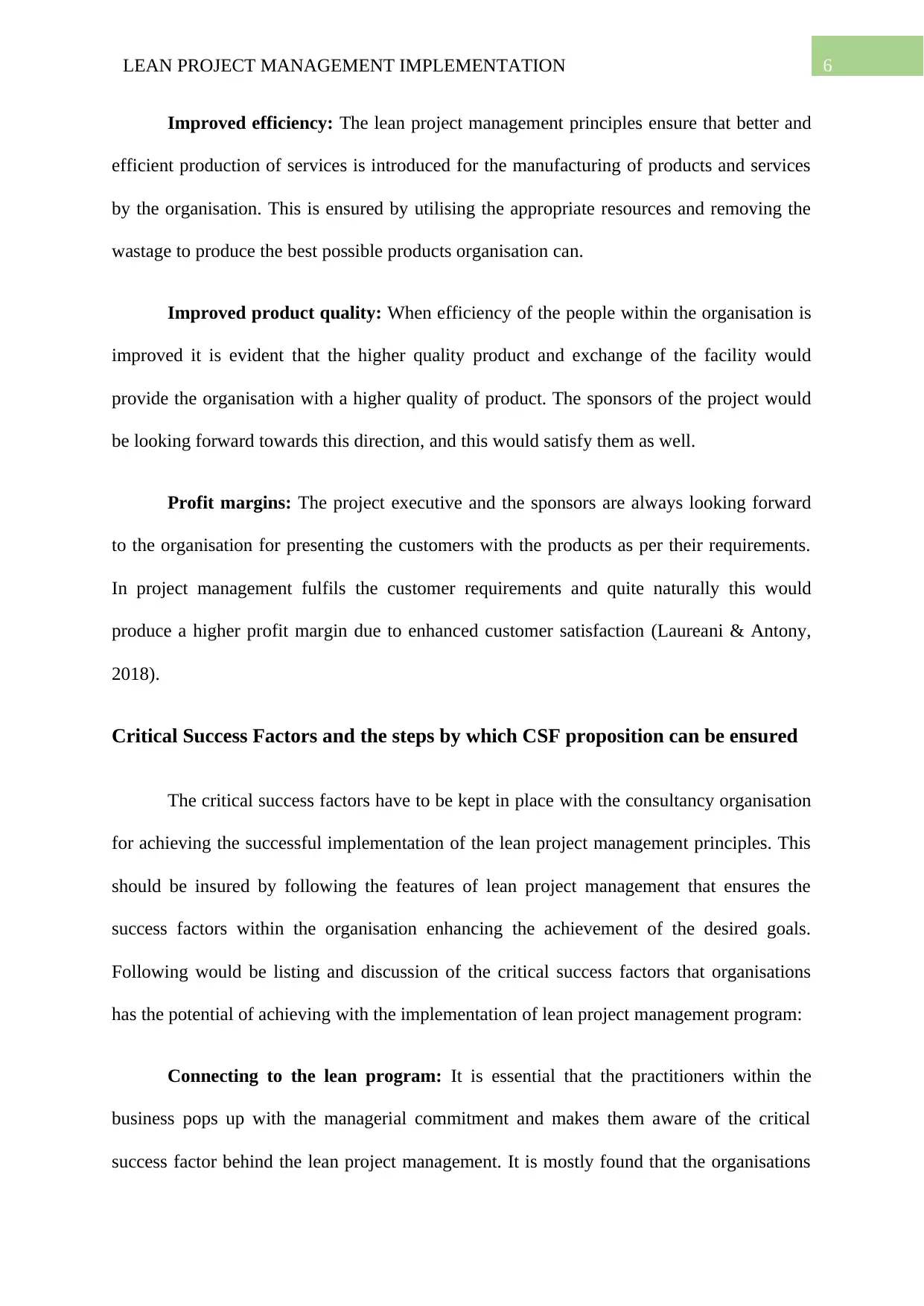
6LEAN PROJECT MANAGEMENT IMPLEMENTATION
Improved efficiency: The lean project management principles ensure that better and
efficient production of services is introduced for the manufacturing of products and services
by the organisation. This is ensured by utilising the appropriate resources and removing the
wastage to produce the best possible products organisation can.
Improved product quality: When efficiency of the people within the organisation is
improved it is evident that the higher quality product and exchange of the facility would
provide the organisation with a higher quality of product. The sponsors of the project would
be looking forward towards this direction, and this would satisfy them as well.
Profit margins: The project executive and the sponsors are always looking forward
to the organisation for presenting the customers with the products as per their requirements.
In project management fulfils the customer requirements and quite naturally this would
produce a higher profit margin due to enhanced customer satisfaction (Laureani & Antony,
2018).
Critical Success Factors and the steps by which CSF proposition can be ensured
The critical success factors have to be kept in place with the consultancy organisation
for achieving the successful implementation of the lean project management principles. This
should be insured by following the features of lean project management that ensures the
success factors within the organisation enhancing the achievement of the desired goals.
Following would be listing and discussion of the critical success factors that organisations
has the potential of achieving with the implementation of lean project management program:
Connecting to the lean program: It is essential that the practitioners within the
business pops up with the managerial commitment and makes them aware of the critical
success factor behind the lean project management. It is mostly found that the organisations
Improved efficiency: The lean project management principles ensure that better and
efficient production of services is introduced for the manufacturing of products and services
by the organisation. This is ensured by utilising the appropriate resources and removing the
wastage to produce the best possible products organisation can.
Improved product quality: When efficiency of the people within the organisation is
improved it is evident that the higher quality product and exchange of the facility would
provide the organisation with a higher quality of product. The sponsors of the project would
be looking forward towards this direction, and this would satisfy them as well.
Profit margins: The project executive and the sponsors are always looking forward
to the organisation for presenting the customers with the products as per their requirements.
In project management fulfils the customer requirements and quite naturally this would
produce a higher profit margin due to enhanced customer satisfaction (Laureani & Antony,
2018).
Critical Success Factors and the steps by which CSF proposition can be ensured
The critical success factors have to be kept in place with the consultancy organisation
for achieving the successful implementation of the lean project management principles. This
should be insured by following the features of lean project management that ensures the
success factors within the organisation enhancing the achievement of the desired goals.
Following would be listing and discussion of the critical success factors that organisations
has the potential of achieving with the implementation of lean project management program:
Connecting to the lean program: It is essential that the practitioners within the
business pops up with the managerial commitment and makes them aware of the critical
success factor behind the lean project management. It is mostly found that the organisations
Paraphrase This Document
Need a fresh take? Get an instant paraphrase of this document with our AI Paraphraser
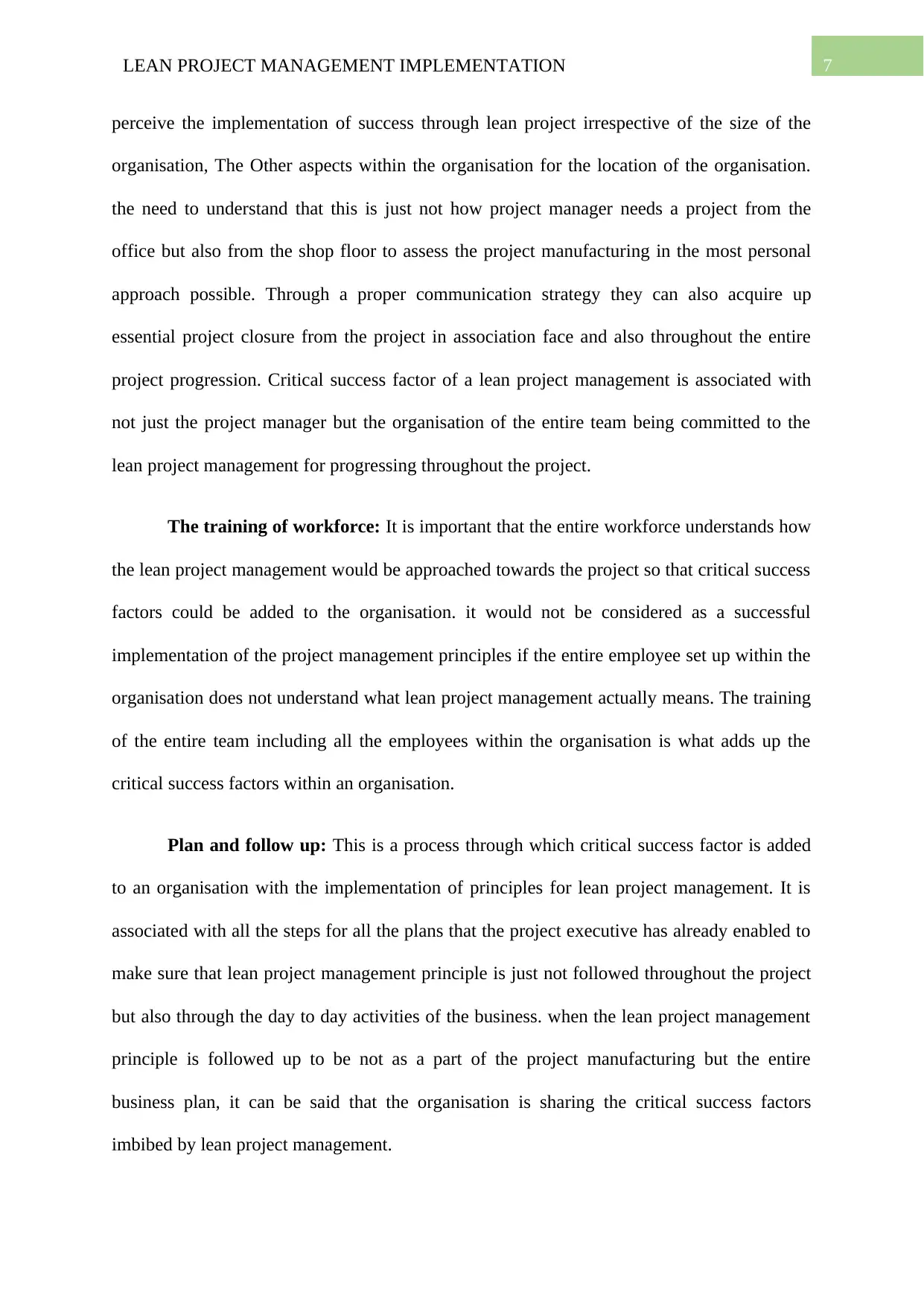
7LEAN PROJECT MANAGEMENT IMPLEMENTATION
perceive the implementation of success through lean project irrespective of the size of the
organisation, The Other aspects within the organisation for the location of the organisation.
the need to understand that this is just not how project manager needs a project from the
office but also from the shop floor to assess the project manufacturing in the most personal
approach possible. Through a proper communication strategy they can also acquire up
essential project closure from the project in association face and also throughout the entire
project progression. Critical success factor of a lean project management is associated with
not just the project manager but the organisation of the entire team being committed to the
lean project management for progressing throughout the project.
The training of workforce: It is important that the entire workforce understands how
the lean project management would be approached towards the project so that critical success
factors could be added to the organisation. it would not be considered as a successful
implementation of the project management principles if the entire employee set up within the
organisation does not understand what lean project management actually means. The training
of the entire team including all the employees within the organisation is what adds up the
critical success factors within an organisation.
Plan and follow up: This is a process through which critical success factor is added
to an organisation with the implementation of principles for lean project management. It is
associated with all the steps for all the plans that the project executive has already enabled to
make sure that lean project management principle is just not followed throughout the project
but also through the day to day activities of the business. when the lean project management
principle is followed up to be not as a part of the project manufacturing but the entire
business plan, it can be said that the organisation is sharing the critical success factors
imbibed by lean project management.
perceive the implementation of success through lean project irrespective of the size of the
organisation, The Other aspects within the organisation for the location of the organisation.
the need to understand that this is just not how project manager needs a project from the
office but also from the shop floor to assess the project manufacturing in the most personal
approach possible. Through a proper communication strategy they can also acquire up
essential project closure from the project in association face and also throughout the entire
project progression. Critical success factor of a lean project management is associated with
not just the project manager but the organisation of the entire team being committed to the
lean project management for progressing throughout the project.
The training of workforce: It is important that the entire workforce understands how
the lean project management would be approached towards the project so that critical success
factors could be added to the organisation. it would not be considered as a successful
implementation of the project management principles if the entire employee set up within the
organisation does not understand what lean project management actually means. The training
of the entire team including all the employees within the organisation is what adds up the
critical success factors within an organisation.
Plan and follow up: This is a process through which critical success factor is added
to an organisation with the implementation of principles for lean project management. It is
associated with all the steps for all the plans that the project executive has already enabled to
make sure that lean project management principle is just not followed throughout the project
but also through the day to day activities of the business. when the lean project management
principle is followed up to be not as a part of the project manufacturing but the entire
business plan, it can be said that the organisation is sharing the critical success factors
imbibed by lean project management.
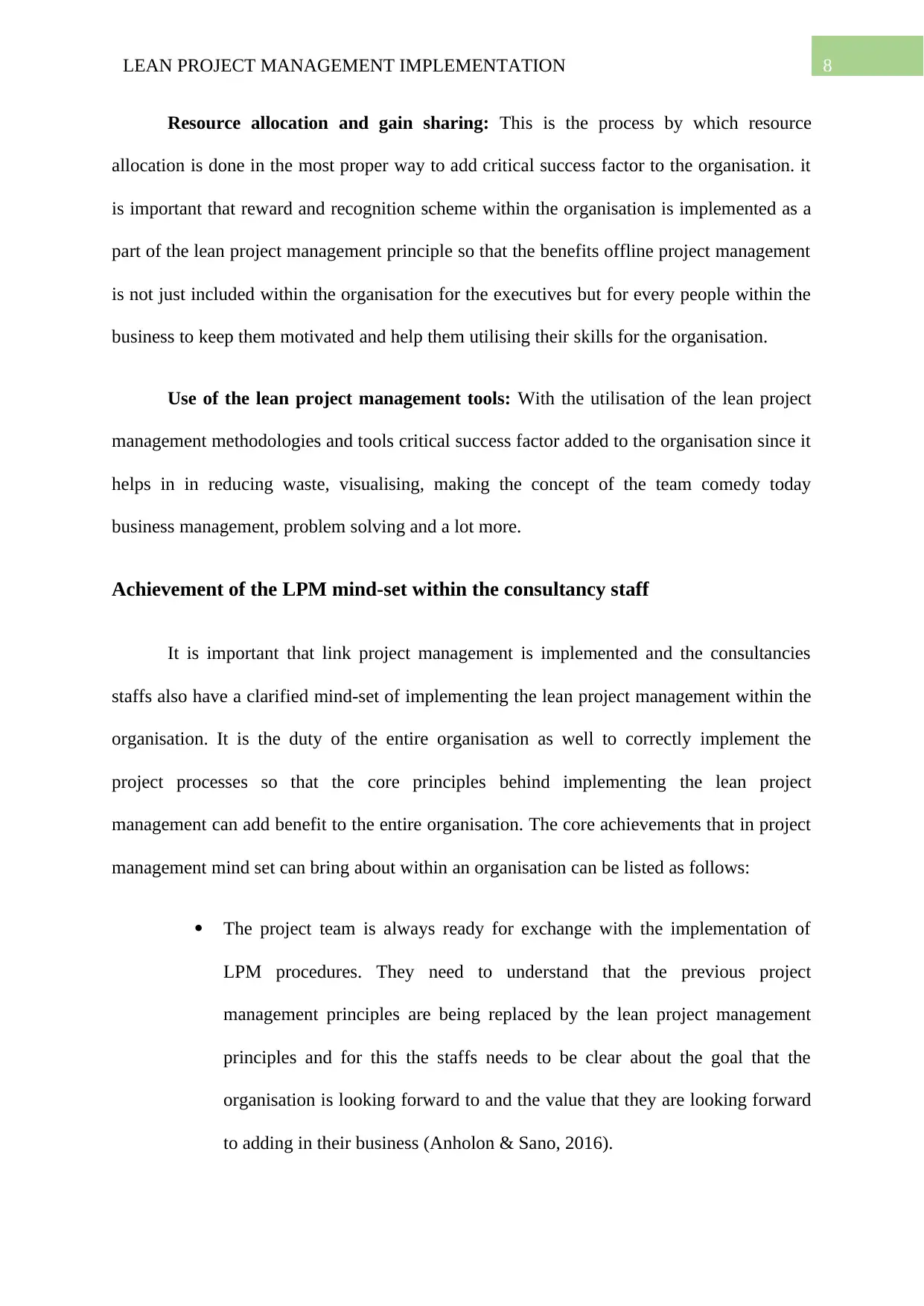
8LEAN PROJECT MANAGEMENT IMPLEMENTATION
Resource allocation and gain sharing: This is the process by which resource
allocation is done in the most proper way to add critical success factor to the organisation. it
is important that reward and recognition scheme within the organisation is implemented as a
part of the lean project management principle so that the benefits offline project management
is not just included within the organisation for the executives but for every people within the
business to keep them motivated and help them utilising their skills for the organisation.
Use of the lean project management tools: With the utilisation of the lean project
management methodologies and tools critical success factor added to the organisation since it
helps in in reducing waste, visualising, making the concept of the team comedy today
business management, problem solving and a lot more.
Achievement of the LPM mind-set within the consultancy staff
It is important that link project management is implemented and the consultancies
staffs also have a clarified mind-set of implementing the lean project management within the
organisation. It is the duty of the entire organisation as well to correctly implement the
project processes so that the core principles behind implementing the lean project
management can add benefit to the entire organisation. The core achievements that in project
management mind set can bring about within an organisation can be listed as follows:
The project team is always ready for exchange with the implementation of
LPM procedures. They need to understand that the previous project
management principles are being replaced by the lean project management
principles and for this the staffs needs to be clear about the goal that the
organisation is looking forward to and the value that they are looking forward
to adding in their business (Anholon & Sano, 2016).
Resource allocation and gain sharing: This is the process by which resource
allocation is done in the most proper way to add critical success factor to the organisation. it
is important that reward and recognition scheme within the organisation is implemented as a
part of the lean project management principle so that the benefits offline project management
is not just included within the organisation for the executives but for every people within the
business to keep them motivated and help them utilising their skills for the organisation.
Use of the lean project management tools: With the utilisation of the lean project
management methodologies and tools critical success factor added to the organisation since it
helps in in reducing waste, visualising, making the concept of the team comedy today
business management, problem solving and a lot more.
Achievement of the LPM mind-set within the consultancy staff
It is important that link project management is implemented and the consultancies
staffs also have a clarified mind-set of implementing the lean project management within the
organisation. It is the duty of the entire organisation as well to correctly implement the
project processes so that the core principles behind implementing the lean project
management can add benefit to the entire organisation. The core achievements that in project
management mind set can bring about within an organisation can be listed as follows:
The project team is always ready for exchange with the implementation of
LPM procedures. They need to understand that the previous project
management principles are being replaced by the lean project management
principles and for this the staffs needs to be clear about the goal that the
organisation is looking forward to and the value that they are looking forward
to adding in their business (Anholon & Sano, 2016).
⊘ This is a preview!⊘
Do you want full access?
Subscribe today to unlock all pages.

Trusted by 1+ million students worldwide
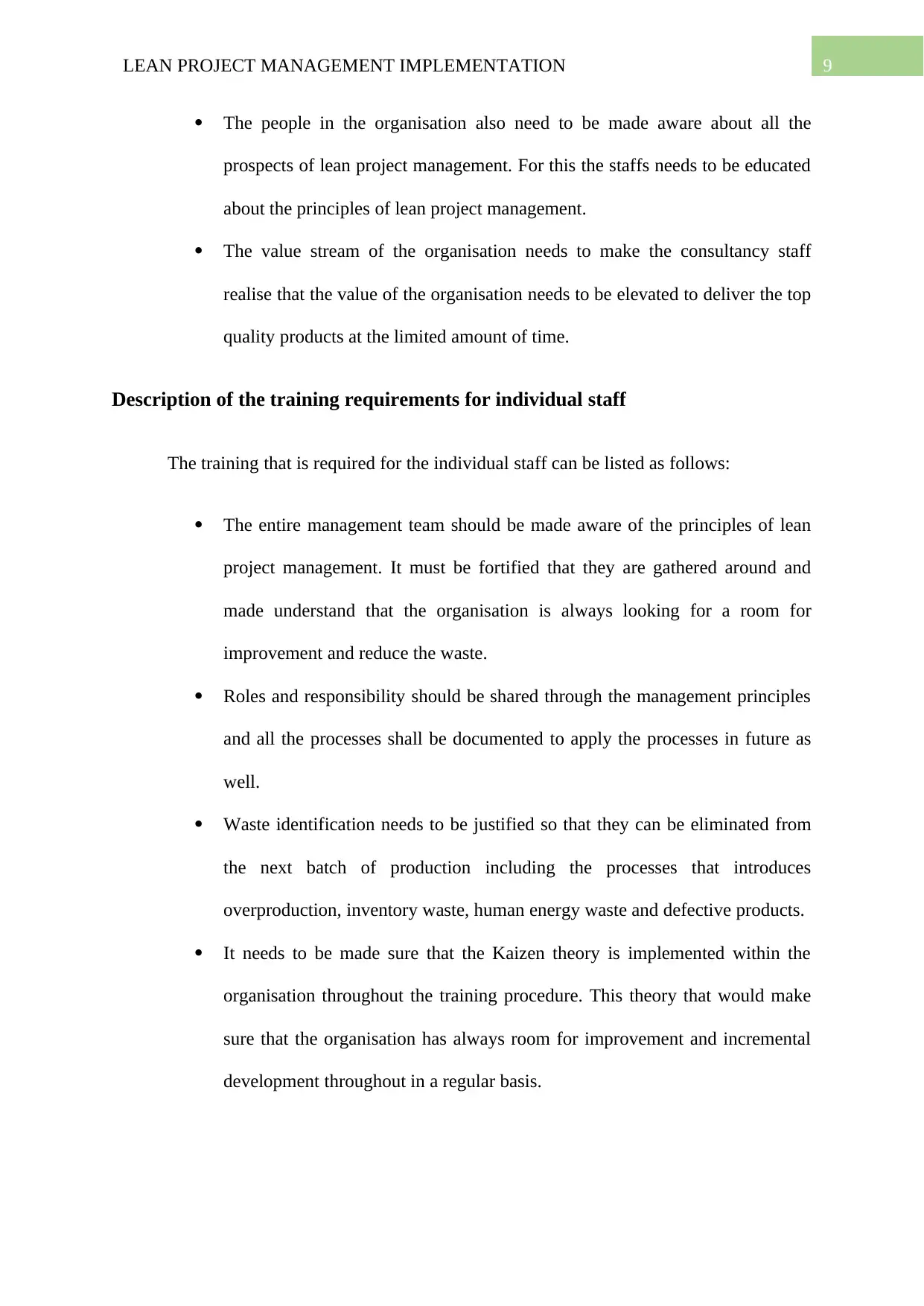
9LEAN PROJECT MANAGEMENT IMPLEMENTATION
The people in the organisation also need to be made aware about all the
prospects of lean project management. For this the staffs needs to be educated
about the principles of lean project management.
The value stream of the organisation needs to make the consultancy staff
realise that the value of the organisation needs to be elevated to deliver the top
quality products at the limited amount of time.
Description of the training requirements for individual staff
The training that is required for the individual staff can be listed as follows:
The entire management team should be made aware of the principles of lean
project management. It must be fortified that they are gathered around and
made understand that the organisation is always looking for a room for
improvement and reduce the waste.
Roles and responsibility should be shared through the management principles
and all the processes shall be documented to apply the processes in future as
well.
Waste identification needs to be justified so that they can be eliminated from
the next batch of production including the processes that introduces
overproduction, inventory waste, human energy waste and defective products.
It needs to be made sure that the Kaizen theory is implemented within the
organisation throughout the training procedure. This theory that would make
sure that the organisation has always room for improvement and incremental
development throughout in a regular basis.
The people in the organisation also need to be made aware about all the
prospects of lean project management. For this the staffs needs to be educated
about the principles of lean project management.
The value stream of the organisation needs to make the consultancy staff
realise that the value of the organisation needs to be elevated to deliver the top
quality products at the limited amount of time.
Description of the training requirements for individual staff
The training that is required for the individual staff can be listed as follows:
The entire management team should be made aware of the principles of lean
project management. It must be fortified that they are gathered around and
made understand that the organisation is always looking for a room for
improvement and reduce the waste.
Roles and responsibility should be shared through the management principles
and all the processes shall be documented to apply the processes in future as
well.
Waste identification needs to be justified so that they can be eliminated from
the next batch of production including the processes that introduces
overproduction, inventory waste, human energy waste and defective products.
It needs to be made sure that the Kaizen theory is implemented within the
organisation throughout the training procedure. This theory that would make
sure that the organisation has always room for improvement and incremental
development throughout in a regular basis.
Paraphrase This Document
Need a fresh take? Get an instant paraphrase of this document with our AI Paraphraser
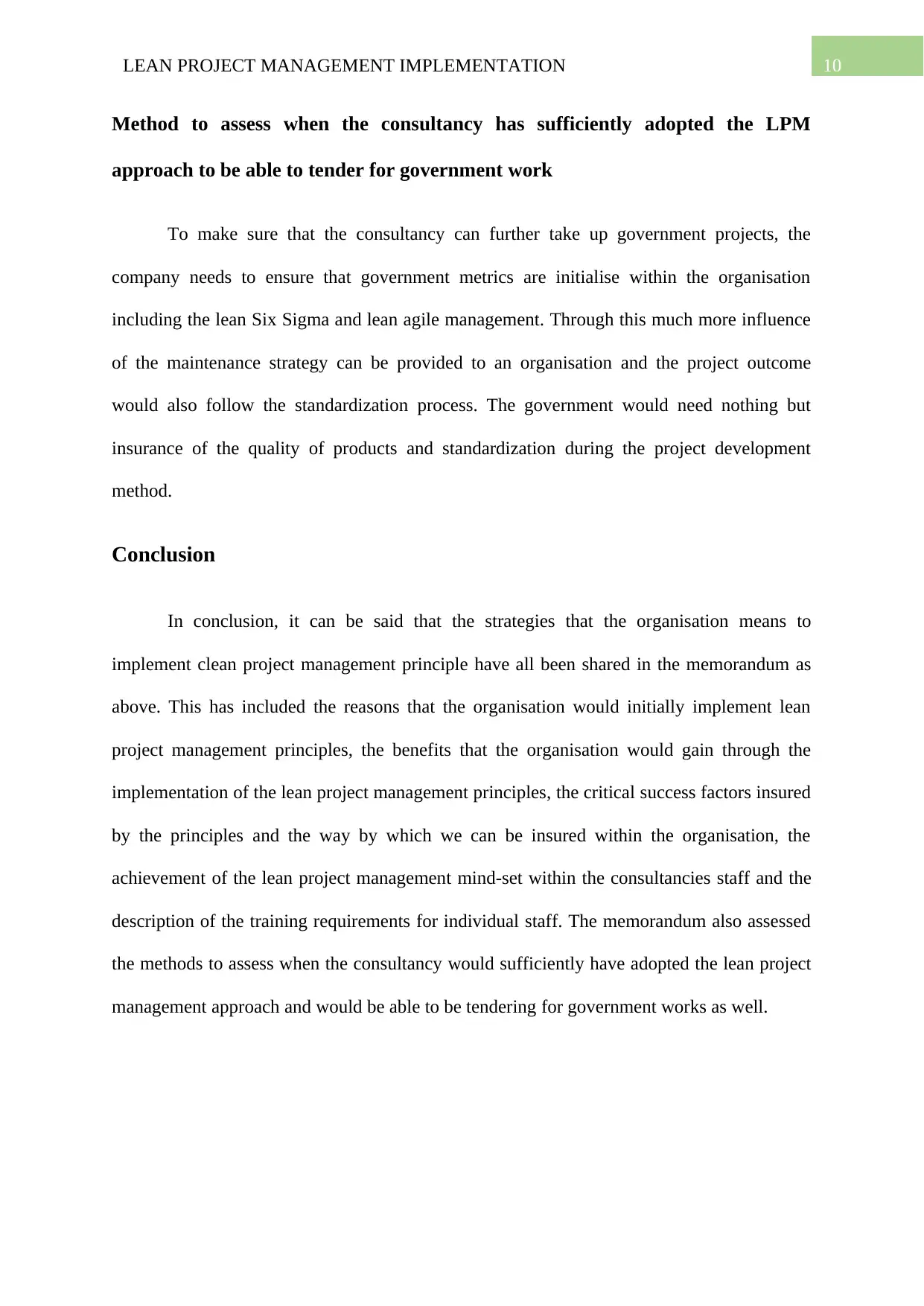
10LEAN PROJECT MANAGEMENT IMPLEMENTATION
Method to assess when the consultancy has sufficiently adopted the LPM
approach to be able to tender for government work
To make sure that the consultancy can further take up government projects, the
company needs to ensure that government metrics are initialise within the organisation
including the lean Six Sigma and lean agile management. Through this much more influence
of the maintenance strategy can be provided to an organisation and the project outcome
would also follow the standardization process. The government would need nothing but
insurance of the quality of products and standardization during the project development
method.
Conclusion
In conclusion, it can be said that the strategies that the organisation means to
implement clean project management principle have all been shared in the memorandum as
above. This has included the reasons that the organisation would initially implement lean
project management principles, the benefits that the organisation would gain through the
implementation of the lean project management principles, the critical success factors insured
by the principles and the way by which we can be insured within the organisation, the
achievement of the lean project management mind-set within the consultancies staff and the
description of the training requirements for individual staff. The memorandum also assessed
the methods to assess when the consultancy would sufficiently have adopted the lean project
management approach and would be able to be tendering for government works as well.
Method to assess when the consultancy has sufficiently adopted the LPM
approach to be able to tender for government work
To make sure that the consultancy can further take up government projects, the
company needs to ensure that government metrics are initialise within the organisation
including the lean Six Sigma and lean agile management. Through this much more influence
of the maintenance strategy can be provided to an organisation and the project outcome
would also follow the standardization process. The government would need nothing but
insurance of the quality of products and standardization during the project development
method.
Conclusion
In conclusion, it can be said that the strategies that the organisation means to
implement clean project management principle have all been shared in the memorandum as
above. This has included the reasons that the organisation would initially implement lean
project management principles, the benefits that the organisation would gain through the
implementation of the lean project management principles, the critical success factors insured
by the principles and the way by which we can be insured within the organisation, the
achievement of the lean project management mind-set within the consultancies staff and the
description of the training requirements for individual staff. The memorandum also assessed
the methods to assess when the consultancy would sufficiently have adopted the lean project
management approach and would be able to be tendering for government works as well.
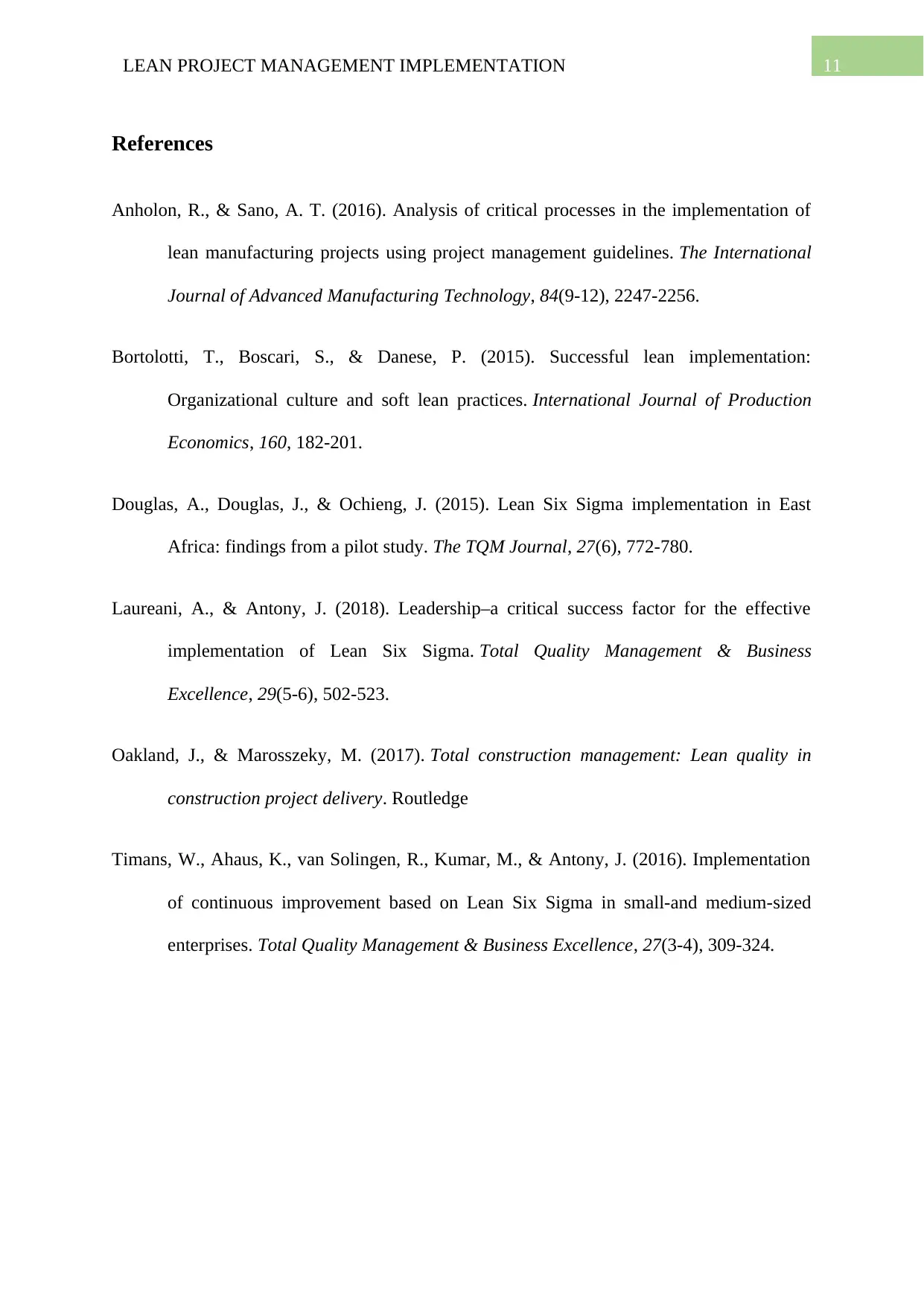
11LEAN PROJECT MANAGEMENT IMPLEMENTATION
References
Anholon, R., & Sano, A. T. (2016). Analysis of critical processes in the implementation of
lean manufacturing projects using project management guidelines. The International
Journal of Advanced Manufacturing Technology, 84(9-12), 2247-2256.
Bortolotti, T., Boscari, S., & Danese, P. (2015). Successful lean implementation:
Organizational culture and soft lean practices. International Journal of Production
Economics, 160, 182-201.
Douglas, A., Douglas, J., & Ochieng, J. (2015). Lean Six Sigma implementation in East
Africa: findings from a pilot study. The TQM Journal, 27(6), 772-780.
Laureani, A., & Antony, J. (2018). Leadership–a critical success factor for the effective
implementation of Lean Six Sigma. Total Quality Management & Business
Excellence, 29(5-6), 502-523.
Oakland, J., & Marosszeky, M. (2017). Total construction management: Lean quality in
construction project delivery. Routledge
Timans, W., Ahaus, K., van Solingen, R., Kumar, M., & Antony, J. (2016). Implementation
of continuous improvement based on Lean Six Sigma in small-and medium-sized
enterprises. Total Quality Management & Business Excellence, 27(3-4), 309-324.
References
Anholon, R., & Sano, A. T. (2016). Analysis of critical processes in the implementation of
lean manufacturing projects using project management guidelines. The International
Journal of Advanced Manufacturing Technology, 84(9-12), 2247-2256.
Bortolotti, T., Boscari, S., & Danese, P. (2015). Successful lean implementation:
Organizational culture and soft lean practices. International Journal of Production
Economics, 160, 182-201.
Douglas, A., Douglas, J., & Ochieng, J. (2015). Lean Six Sigma implementation in East
Africa: findings from a pilot study. The TQM Journal, 27(6), 772-780.
Laureani, A., & Antony, J. (2018). Leadership–a critical success factor for the effective
implementation of Lean Six Sigma. Total Quality Management & Business
Excellence, 29(5-6), 502-523.
Oakland, J., & Marosszeky, M. (2017). Total construction management: Lean quality in
construction project delivery. Routledge
Timans, W., Ahaus, K., van Solingen, R., Kumar, M., & Antony, J. (2016). Implementation
of continuous improvement based on Lean Six Sigma in small-and medium-sized
enterprises. Total Quality Management & Business Excellence, 27(3-4), 309-324.
⊘ This is a preview!⊘
Do you want full access?
Subscribe today to unlock all pages.

Trusted by 1+ million students worldwide
1 out of 12
Related Documents
Your All-in-One AI-Powered Toolkit for Academic Success.
+13062052269
info@desklib.com
Available 24*7 on WhatsApp / Email
![[object Object]](/_next/static/media/star-bottom.7253800d.svg)
Unlock your academic potential
Copyright © 2020–2025 A2Z Services. All Rights Reserved. Developed and managed by ZUCOL.


